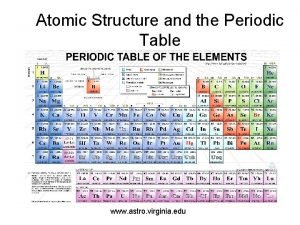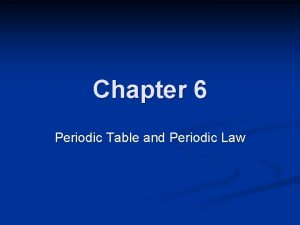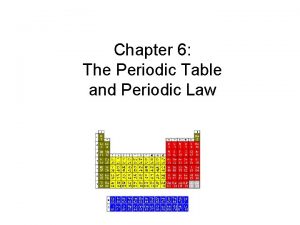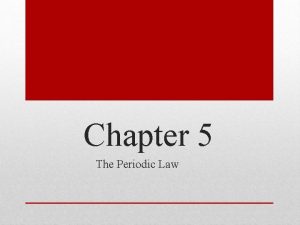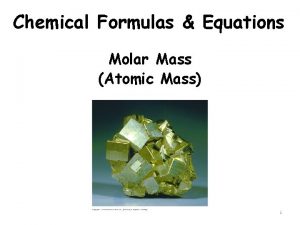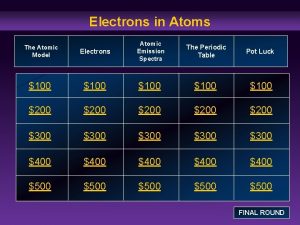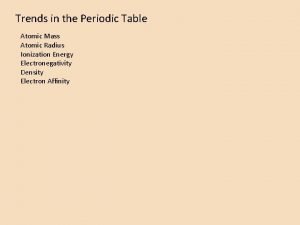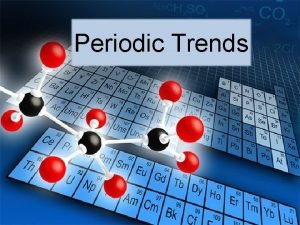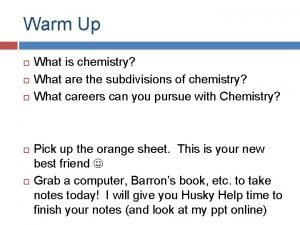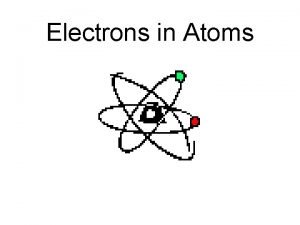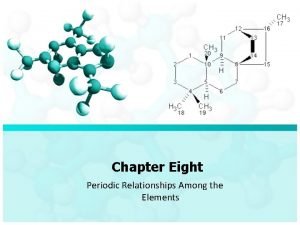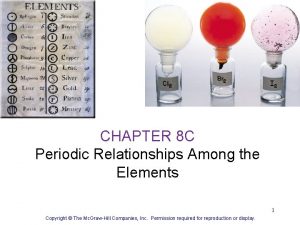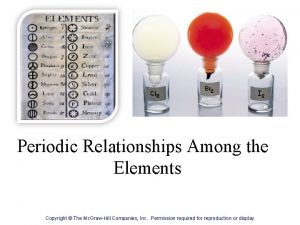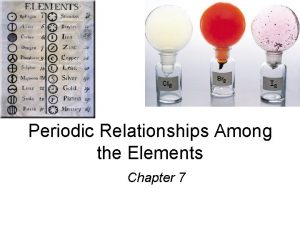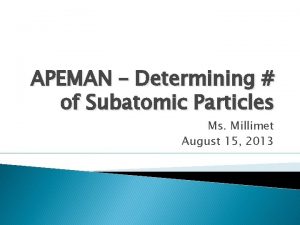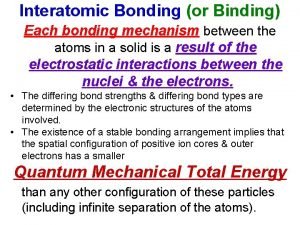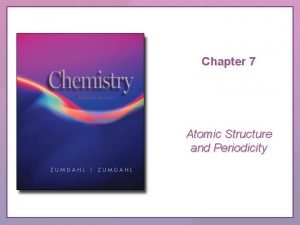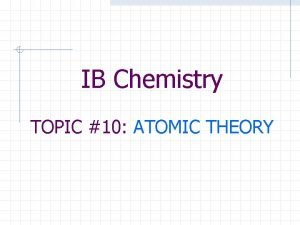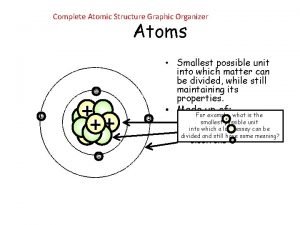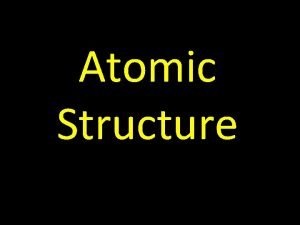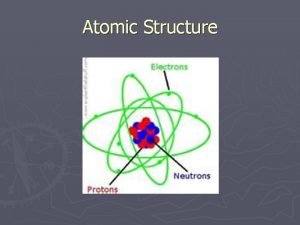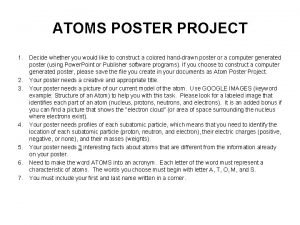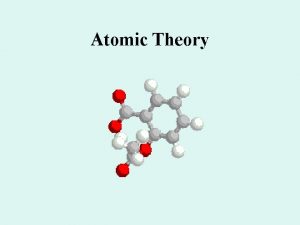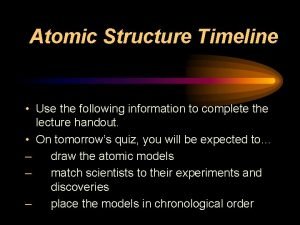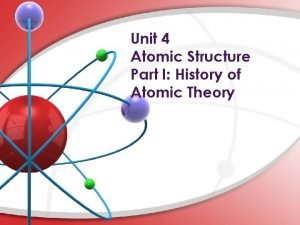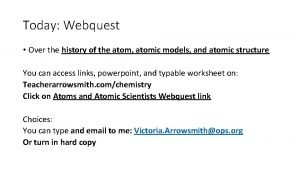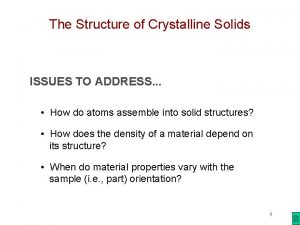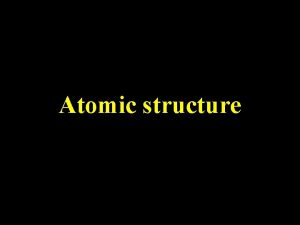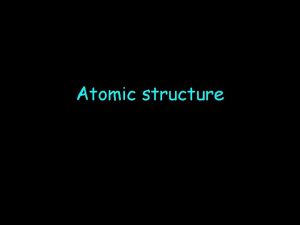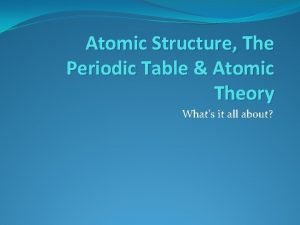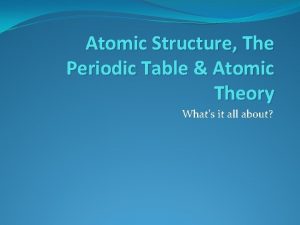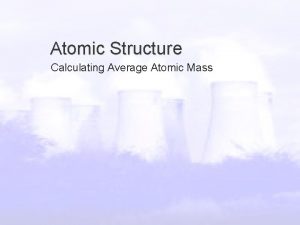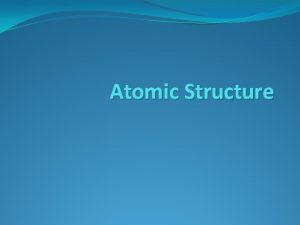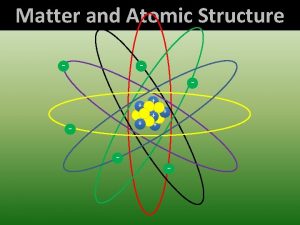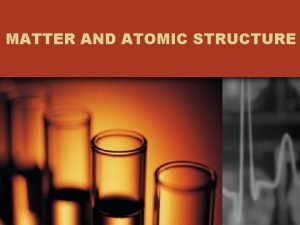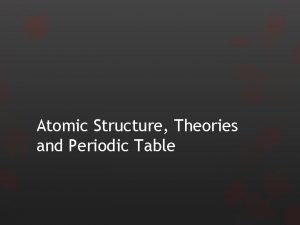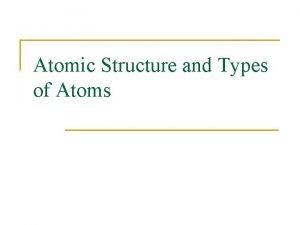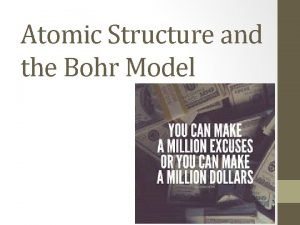Atomic Structure and Periodic Relationships 2 3 ns












































- Slides: 44

Atomic Structure and Periodic Relationships

2 3 ns np Which of these elements is found in a family with the above electron configuration? ns 2 np 3 = 5 valance electrons A B C D Al Group 15 Sr Si Sb

How many protons, neutrons, and electrons are in a neutral atom of sodium? A 11 p+, 12 no, 11 e. B 11 p+, 11 no, 12 e. C 12 p+, 11 no, 12 e. D 12 p+, 11 no, 11 e-

Which of the following describes what takes place when 0 2+ iron (Fe ) is oxidized to Fe ions? A B C D A gain of two electrons A loss of two electrons A gain of two protons A loss of two protons + ions lose electrons - Ions gain electrons

Which scientist was the first to conclude through experimentation that atoms have positive charges in their nuclei? A. Bohr B. Dalton C. Mosley D. Rutherford

Which grouping identifies chemical properties? A. Malleability, ductility, conductivity Physical B. Luster, hardness, texture Physical C. Combustibility, flammability, reactivity D. Density, melting point, boiling point Physical

Electronegativity differences are often helpful in determining the bond character between two atoms. A general rule states that if the electronegativity difference between two atoms is greater than 1. 67, an ionic bond would most likely be formed. Using the chart above, which pair of atoms would probably form the strongest ionic bond? A. Al-P (2. 1 – 1. 5 = 0. 6) A. Al-P B. Na-Cl (3. 0 – 0. 9 = 2. 1) B. Na-Cl C. K-F (4. 0 -0. 8 = 3. 2) C. K-F D. Ca-O (3. 5 -1. 0 = 2. 5) D. Ca-O

Three elements, X, Y, and Z, have consecutive increasing atomic numbers. If element X is a noble gas, what will be the symbol for the ion of element Z in its compounds? A. Z 2 B. ZC. Z+ D. Z 2+ Group 2 = 2+

From left to right across a period, what change is occurring within the atomic nuclei? Atomic number = # Protons A. A proton is gained. B. An electron is gained. C. A neutron is lost. D. The electron cloud size is decreasing

Radioactive iodine-131 has a halflife of eight days. The amount of a 200. 0 gram sample left after 32 days would be — A. 6. 25 g B. 12. 5 g C. 25. 0 g D. 50. 0 g

Radioactive iodine-131 has a halflife of eight days. The amount of a 200. 0 gram sample left after 32 days would be —

Radioactive iodine-131 has a halflife of eight days. The amount of a 200. 0 gram sample left after 32 days would be — A. 6. 25 g B. 12. 5 g C. 25. 0 g D. 50. 0 g

Which of these describes a tendency for atomic radii as displayed on the periodic chart? A. Atomic radii decrease left to right across a period. B. Atomic radii increase left to right across a period. C. Atomic radii decrease top to bottom down a group. D. Atomic radii increase, then decrease from top to bottom down a group.

Which of these conclusions can be drawn from Rutherford’s experiment? Most alpha particles went straight through the gold foil A. Each atom contains electrons. B. The nucleus of an atom can be split. C. Each atom contains protons. D. Atoms are mostly empty space

How does the radioactive isotope C -14 differ from its stable C-14 = 6 p+ and 8 n counterpart C-12? o C-12 = 6 p+ and 6 no A. It has a different number of protons and two less neutrons than C-12. B. It has the same number of protons and two more electrons than C-12. C. It has the same number of protons but two more neutrons than C-12. D. It has a different number of protons and two more neutrons than C-12.

Atoms of the same element must — A. contain the same number of neutrons B. have the same mass number C. contain the same number of protons D. have equal numbers of protons and neutrons Protons identify the element!

The understanding that the position of an electron in an electron cloud cannot precisely be determined was developed by Werner I am uncertain Heisenberg and is known as the — where the e- is A. planetary model B. uncertainty principle C. quantum theory D. first atomic theory located!

A. A B. B C. C D. D The chart above shows the relationship between the first ionization potential and the increase in atomic number. The letter on the chart that indicates the noble gases or the inert elements is —

Chlorine forms a 1– ion. How many electrons does a chloride ion have? A. 1 B. 16 C. 17 D. 18 Cl = 17 e-; -1 = 1 e- = 18

Isotopes of an element have different — A. atomic numbers B. atomic masses C. numbers of protons D. numbers of outer-shell electrons

The alkali metals are located in which group of the periodic table? A. 1 B. 2 C. 3 D. 4

An element has an electron configuration of 1 s 22 p 63 s 2. Which of these will be in the same group as this element? A. 1 s 22 p 6 B. 1 s 22 p 63 s 23 p 64 s 2 C. 1 s 22 p 63 s 1 D. 1 s 22 p 63 s 23 p 6

Which of these is an ion with a charge of 1+? A. 1 B. 2 C. 3 D. 4 Atoms are electrically neutral therefore Electrons = Protons

Which of these elements is the most chemically active? A. F B. Cl C. Br D. I

The elements that are characterized by having only five electrons in the p sublevel belong to which family of elements? z A. Transition B. Alkali C. Noble gas D. Halogens z z y x Pz Px x y Py

An increase in atomic number is related to an increase in atomic mass because — A. more electrons are present in the atomic nucleus B. more electrons are orbiting the atomic nucleus C. more protons are present in the atomic nucleus D. more protons are orbiting the atomic nucleus

Which of these elements contains four valence electrons? A. Helium B. Beryllium C. Carbon D. Oxygen

Which of the following orbital diagrams is incorrect because it violates Hund’s rule? When several orbitals of equal energy are available, electrons enter singly with parallel spins

What is the main similarity among elements in group 2? A. Atomic radius B. Chemical properties C. Mass number D. Boiling point

A neutral atom of aluminum-27 contains A. 13 protons and 27 electrons B. 14 protons and 13 neutrons C. 13 electrons, 13 protons, and 14 neutrons D. 13 electrons, 14 protons, and 13 neutrons

Which of the above elements is a positive ion with a charge of one? A. 1 B. 2 C. 3 D. 4

Cations are formed when neutral atoms lose — A. electrons B. protons C. neutrons D. positrons

Which of the following properties decreases from left to right across a period? A. Atomic number B. Electronegativity C. Atomic radius D. Ionization energy

The atomic number corresponds to an atom’s number of — A. protons B. neutrons C. electrons D. positrons

Which element naturally occurs as a diatomic molecule? A. Zn B. C C. K D. H H 2 Magnificent 7 Cl 2 N 2 O 2 I 2 F 2 Br 2

How many valence electrons does a neutral atom of silicon have? A. 3 B. 4 C. 5 D. 6

At room temperature, chlorine exists as a gas, bromine exists as a liquid, and iodine exists as a solid. The physical states of these elements indicate that melting point — A. decreases from top to bottom with group 17 elements B. is independent of periodic position C. increases from top to bottom within group 17 elements D. is constant within group 17 elements

Which represents an atom of calcium? A. 1 B. 2 C. 3 D. 4 Calcium has an atomic number of 20 or 20 protons. If electrons are not equal to protons it is an ion not an atom. .

A scientist has found the following isotope of oxygen: How many neutrons are present in this isotope? 19 - 8 = 11 A. 8 B. 11 C. 19 D. 27

The elements that are characterized by the presence of an incomplete d sublevel are called — A. transition elements B. alkali earth metals C. halogens D. lanthanoids

The net charge on an aluminum ion is 3 because there are — A. 10 protons and 13 electrons in the atom B. 13 protons and 10 neutrons in the nucleus C. 10 neutrons and 13 electrons in the atom D. 13 protons and 10 electrons in the atom Al’s atomic number is 13 therefore it has 13 electrons and 13 protons but when it forms an ion it loses 3 electrons to achieve the configuration of a Nobel gas!

Which of the following is a mixture? A. Carbon B. Glucose C. Distilled water D. Air

One indicator that electrons in atoms are limited to specific energy levels is that — A. atoms move faster when heated B. the light given off by atoms is all at the same wavelength C. the Doppler effect shows a shift in wavelength for H-atom light D. light emitted from excited atoms occurs only at specific wavelengths

The End
 Atomic structure periodic table
Atomic structure periodic table Is atomic mass and relative atomic mass the same
Is atomic mass and relative atomic mass the same Mass of oxygen
Mass of oxygen Distinguish between mass number and atomic mass.
Distinguish between mass number and atomic mass. Perioidic trends
Perioidic trends Atomic radii trend
Atomic radii trend Atomic number vs atomic radius
Atomic number vs atomic radius Chapter 6 the periodic table
Chapter 6 the periodic table The periodic table and periodic law chapter 6
The periodic table and periodic law chapter 6 Chapter 5 periodic law
Chapter 5 periodic law Atomic radius periodic table
Atomic radius periodic table Periodic table w molar mass
Periodic table w molar mass Atomic emission spectra periodic table
Atomic emission spectra periodic table Atomic mass trends
Atomic mass trends Is sulfer a cation or anion
Is sulfer a cation or anion نصف القطر الذري
نصف القطر الذري Increasing atomic size periodic table
Increasing atomic size periodic table Periodic relationships among the elements
Periodic relationships among the elements Periodic relationships among the elements
Periodic relationships among the elements Periodic relationships among the elements
Periodic relationships among the elements Decreasing electronegativity
Decreasing electronegativity Periodic relationships
Periodic relationships Elements in period 2
Elements in period 2 Atomic structure and properties ap chemistry
Atomic structure and properties ap chemistry Ap chemistry atomic structure and periodicity
Ap chemistry atomic structure and periodicity Apeman periodic table
Apeman periodic table Ap chemistry chapter 7 atomic structure and periodicity
Ap chemistry chapter 7 atomic structure and periodicity Atomic structure and interatomic bonding
Atomic structure and interatomic bonding Chapter 7 atomic structure and periodicity
Chapter 7 atomic structure and periodicity Subatomic particles chart
Subatomic particles chart Atomic universe theory
Atomic universe theory Atomic structure of conductors
Atomic structure of conductors What is z in atomic structure
What is z in atomic structure First ionization energy of calcium
First ionization energy of calcium Atomic structure graphic organizer
Atomic structure graphic organizer Atomic theory models timeline
Atomic theory models timeline What is z in atomic structure
What is z in atomic structure Tungsten atomic structure
Tungsten atomic structure 460 democritus atom model
460 democritus atom model Atomic structure poster project
Atomic structure poster project Atomic structure graphic organizer
Atomic structure graphic organizer Atomic model schrodinger
Atomic model schrodinger Schrodinger
Schrodinger Atomic structure webquest
Atomic structure webquest Packing fraction of bcc
Packing fraction of bcc
